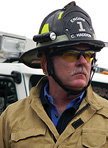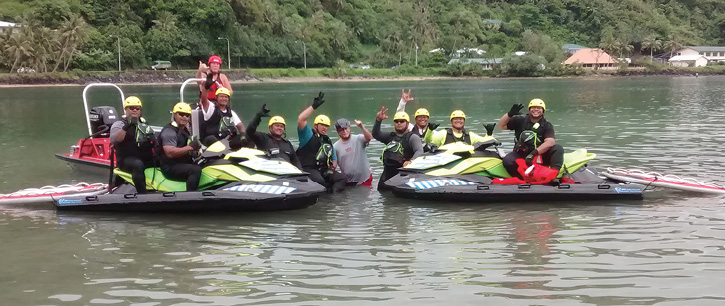
By Carl J. Haddon
About 16 months ago, I wrote part 1 of this article (Fire Apparatus & Emergency Equipment, October 2018). I outlined a project on the South Pacific American Territory island of American Samoa.

The airport rescue and firefighting (ARFF) crew at the Pago Pago International Airport (PPG) had been tasked with the responsibility of providing coastal water rescue services in the event of an aircraft into the water. The two “heavy” (commercial jetliner) runways parallel each other with a large lagoon on one side and open ocean on the other. The end of the runways juts out into the ocean, where the depth at drop off is more than 600 feet. At the time of the first article, there was no coastal or open water rescue program on this island. Today there is one.
Related Content
- To the Rescue: Saving Volunteer Departments: A Sustainable Solution
- To the Rescue: Wildlife and Livestock Extrication: What Is Old Can Be New Again
- To the Rescue: Buying Extrication Tools? Own the Demo!
This introductory paragraph must read like something a mad scientist or politician came up with, but it is indeed true and this Island/Federal Aviation Administration (FAA)/Department of the Interior project is now coming (as we speak) to fruition. I write this article from my guest room in the village of Faga’alu, on the island of American Samoa. I am one of two instructors conducting the month-long water rescue training sessions here on the island. This is a program that has been two years in the making and has included starting what amounts to a special operations team from the ground (or Pacific Ocean) up. From preplanning, needs assessments, grant writing, and purchasing to a training program for the ARFF firefighters that started with improving basic rescuer swimming proficiency, the program has rapidly progressed from there. This article is about brave souls who are turning a dream into reality, complete with state-of-the-art coastal water rescue equipment, rescue craft, and a training program all custom designed to meet the needs of the American Samoan people and the FAA as well as the air-traveling public.
In the first article, I outlined some of the original needs assessments that were done to write cohesive grant applications. Many of us write grants for lots of things. Most of us are happy if we get even a partial award. Rarely (as in this case) do we see a grant applicant get MORE than what they asked for. This is a true case where not only did this department get the grant (and more) it was after, but the Department of the Interior grant award led to other grant awards, which is allowing the Pago Pago ARFF crews the opportunity to purchase water and other technical rescue personal protective equipment (PPE) and other equipment that they otherwise could never have afforded. Simply stated, this was a project that was rewarded for its members’ planning, tenacity, perseverance, and dedication.
PLANNING
After weeks and months of research and coordinating needs with available grants, our group targeted a Department of the Interior grant for the project. If awarded, this grant would help provide the necessary boats, craft, and water rescue training needed to respond to down aircraft and other local coastal water emergencies here on the island. Once the department was awarded this grant and the purchasing process began, it became evident that the department would also need PPE as well as ancillary water rescue (both land- and water-based) gear and equipment to make this project work. The department’s local grant writer’s efforts again paid off. It seems there was another grant available that acted much like a “tag-along” grant that would provide funding for purchasing PPE and equipment that complemented the water rescue craft that were purchased.

1 Instructors and students with the Pago Pago International Airport’s quick-response, search-and-rescue-style Sea-Doo watercraft with Liquid Shredder inflatable rescue boards. (Photo courtesy of the author.)
PURCHASING
Personal water craft—motorcycle type water craft—seemed to be on the forefront of the department’s mind. As firefighters, who wouldn’t want big new quick-response, search-and-rescue-style Sea-Doo products for their arsenal? The real question was: Are these the right vehicles given the unique “circumstances” here on this South Pacific island? The answer is most definitely yes; however, we quickly determined that these small “rescue rocket ships” could not/cannot operate in these waters and reefs alone. In addition to the 1,500-cc search and rescue Sea Doos, it was determined that a shallow water deck boat, also known as a “skimmer boat,” would be needed to support the intended operations of the PPG ARFF water rescue team. For those unfamiliar, a skimmer boat is a wide-deck, flat-bottomed, outboard jet-motor-propelled craft that only draws 12 to 18 inches of water. Here, a craft like this is essential for use as a patient or recovery shuttle and on-water command platform that allows the Sea Doos to continue on with search and rescue activities. For this craft, the ARFF folks chose a 2056 Rescue Skimmer Boat by Miracle Marine in Michigan. This craft arrived on the island complete with a 90-horsepower Suzuki jet outboard motor.
OPERATIONAL CRAFT USAGE AND TRAINING
Having piloted river and ocean water rescue craft for more years than I care to divulge, I must admit that I was a bit skeptical of the craft choices at first. At the time of this writing, I logged more than 30 hours with these boats on this island, and I have nothing but high praise for the combination. The Sea Doo machines are powerful, fast, and nimble over the reefs and yet stable in outside open water. With the addition of Liquid Shredder inflatable rescue boards, these machines have what it takes for the mission at hand. The honest truth is that I’d love to have a couple of these same machines for my swift whitewater (Salmon River) rescue team at home in Idaho! The Sea Doos work well for initial victim access and size-up, while the 20-foot rescue skimmer provides an intermediate working deck craft that can haul personal flotation devices (PFDs) and personnel to the scene as well as provide shallow water and beaching capabilities in addition to the forward deck being used to transport rescue and recovery victims. It is also a great working boat to deploy our rescue swimmers from. The skimmer boat does have limitations in rough surf or open waters, but it isn’t really designed for open water (ocean) or surf rescue. We are utilizing this versatile deck boat to shuttle personnel and victims to and from other deep water rescue boats as well as directly to shore.
PERSONAL PROTECTIVE EQUIPMENT (PPE)
When we arrived on the island and were shown the complement of PPE that had been purchased with the add-on grant funds, we were pleased with the vast majority of their purchases. One of the items they purchased was a bit puzzling until we, the instructors, did some learning of our own. The ARFF team purchased most of their PPE from NRS in Moscow, Idaho. They got good Class 5 rescuer PFDs, rescue knives, personal locator beacons, lights, whistles, gloves, water rescue boots, throw bags, throw rings, and wetsuits. The last item on my list is the one that concerned me. The group had purchased very nice NRS long john (bib overall style) wetsuits. I explained to them the need to have drysuits, as opposed to wetsuits, insomuch as any down aircraft into the water would create a combination of biohazards as well as chemical hazards with the likelihood of fuel and oils in the water. Drysuits would help to keep rescuers from coming in contact with the bio and chem hazards. Everyone was in agreement that drysuits would indeed be the PPE of choice and that they needed to order them for the team. What they said next is where my surprise came in.
The firefighters told me that although they agreed with the reasoning for the drysuits, they were still going to keep the long john wetsuits. After the conclusion of our first two weeks of training activities, I now have a great appreciation for the wisdom of keeping the wetsuits. The thought behind keeping the wetsuits has nothing to do with water temperature. The seawater here rarely dips below 80°F year-round. In the hot months, water temperatures hover in the high 80s to the low 90s! The chief explained to me that they were going to keep the suits and designate them solely for training activities. The reasoning behind this, which I learned firsthand, is for the abrasion protection. Every beach I’ve encountered on this beautiful island is flanked by spectacular coral reefs. These reefs can be quite shallow depending on the tide. Regardless of the tide, these reefs are very adept at removing skin from your body when you (intentionally or unintentionally) come in contact with them. The wetsuits provide a barrier between skin and reef, without the risk of tearing up an expensive drysuit.
As we readied to launch our last two weeks of operations-level training here on the island, it was refreshing to see our American Samoan brothers eagerly gobbling up all of the training time that they could get, and I am proud to report that they are coming along magnificently. This compliment does not do these brave souls justice. With lots of help from other resources and after a ton of hard work, you’d never know that a significant percentage of these brave souls were nonswimmers or not proficient swimmers prior to our arrival on the island. There are professional and financial obstacles for firefighters on this island that most of us could never begin to imagine. The dedication shown to expand their knowledge base and hone their craft in spite of these obstacles and challenges reminds me of why I continue to love this “sharing of knowledge” (I learn as much or more than I offer) AKA: the job that I have. Stay safe, and train hard, my brothers and sisters; American Samoa is depending on you!
CARL J. HADDON is a member of the Fire Apparatus & Emergency Equipment Editorial Advisory Board and the director of Five Star Fire Training LLC, which is sponsored, in part, by Volvo North America. He served as assistant chief and fire commissioner for the North Fork (ID) Fire Department and is a career veteran of more than 25 years in the fire and EMS services in southern California. He is a certified Level 2 fire instructor and an ISFSI member and teaches Five Star Auto Extrication and NFPA 610 classes across the country.

